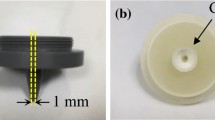Abstract
The Korea Institute of Nuclear Nonproliferation and Control (KINAC) operates the “environmental sampling program” which includes the collection, screening, analysis of samples, and evaluation of the resulting data. The goal of this project is to set up the nuclear material baseline in domestic nuclear facility, so that any future sampling results can then be evaluated using the facility baseline as a reference. For this purpose, 18 swipe samples from three points of the nuclear facility were collected, and the screening test using monochromatic micro-focusing X-ray fluorescence was conducted, followed by particle analysis of the collected swipe samples. The particle analysis was conducted using large geometry-secondary ion mass spectrometry. The MMXRF map was effectively applied for making a decision to select particles from samples for further particle analysis. Based on the results of particle analysis, the baseline for each selected point of the nuclear facility was established, and these datasets will be used as reference for verifying the absence of undeclared activities at the facility in the future. The results showed that the established baseline of the nuclear facility was consistent with the declared activities.






Similar content being viewed by others
References
IAEA (2005) Environmental sampling for safeguards, STR-348, International Atomic Agency SGCP-PSA Inspection Measurement Quality Unit, Vienna Austria
Lee CG, Park J, Lim SH (2018) Accurate determination of minor isotope ratios in individual plutonium–uranium mixed particles by thermal ionization mass spectrometry. Nucl Eng Technol 50(1):140–144
Suzuki D, Saito-Kokubu Y, Sakurai S, Lee CG, Magara M, Iguchi K, Kimura T (2010) A new method for isotope ratio measurement of uranium in trace amount by thermal ionization mass spectrometry: the continuous heating method. Int J Mass Spectrom 294(1):23–27
Becker JS (2005) Recent developments in isotope analysis by advanced mass spectrometric techniques, Plenary lecturel. J Anal At Spectrom 20(11):1173–1184
Saito-Kokubu Y, Suzuki D, Lee CG, Inagawa J, Magara M, Kimura T (2012) Application of a continuous heating method using thermal ionization mass spectrometry to measure isotope ratios of plutonium and uranium in trace amounts of uranium–plutonium mixture sample. Int J Mass Spectrom 310:52–56
Esaka F, Suzuki D, Yomogida T, Magara M (2016) Application of automated particle screening for effective analysis of individual uranium particles by thermal ionization mass spectrometry. Anal Methods 8.7:1543–1548
Hedberg PML, Peres P, Fernandes F, Renaud L (2015) Multiple ion counting measurement strategies by SIMS—a case study from nuclear safeguards and forensics. J Anal At Spectrom 30(12):2516–2524
Hedberg PML, Peres P, Fernandes F, Albert N, Vincent C (2018) Latest improvements in isotopic uranium particle analysis by large geometry—secondary ion mass spectrometry for nuclear safeguards purposes. J Vac Sci Technol B Nanotechnol Microelectron 36.3:03F108
Simons DS, Fassett JD (2017) Measurement of uranium-236 in particles by secondary ion mass spectrometry. J Anal At Spectrom 32(2):393–401
Peres P, Hedberg PML, Rabemananjara F, Cliff JB, Littmann S, Albert N, Vincent C (2013) Nuclear safeguards and nuclear forensic analysis by secondary ion mass spectrometry. In: 33rd ESARDA annual meeting, symposium on safeguards and nuclear material management, paper (no. 11)
Stebelkov V, Elantyev I, Hedberg M, Wallenius M, Fauré AL (2018) Determination of isotopic composition of uranium in the CMX-4 samples by SIMS. J Radioanal Nucl Chem 315(2):417–423
Park J, Kim TH, Lee CG, Lim SH, Han SH (2018) A simple correction method for isobaric interferences induced by lead during uranium isotope analysis using secondary ion mass spectrometry. J Radioanal Nucl Chem 316.3:1273–1280
Kim SH, Song JY, Jeon JY, Choi JY, Seo H (2019) Feasibility study on evaluating uranium enrichment with the high resolution gamma-ray spectrometry and X-ray fluorescence. Appl Radiat Isot 148:132–137
Esaka F, Watanabe K, Fukuyama H, Onodera T, Esaka KT, Magara M, Sakurai S, Usuda S (2004) Efficient isotope ratio analysis of uranium particles in swipe samples by total-reflection X-ray fluorescence spectrometry and secondary ion mass spectrometry. J Nucl Sci Technol 41.11:1027–1032
US Federal Standard (1992) Airborne particulate cleanliness classes in cleanrooms and clean zones, FED-STD-209E
Ranebo Y, Hedberg PML, Whitehouse MJ, Ingeneri K, Littmann S (2009) Improved isotopic SIMS measurements of uranium particles for nuclear safeguard purposes. J Anal At Spectrom 24.3:277–287
Hedberg PML, Peres P, Cliff JB, Rabemananjara F, Littmann S, Thiele H, Vincent C, Albert N (2011) Improved particle location and isotopic screening measurements of sub-micron sized particles by secondary ion mass spectrometry. J Anal At Spectrom 26(2):406–413
Meyers LS, Gamst G, Guarino Anthony J (2006) Applied multivariate research: design and interpretation. Sage publications, Thousand Oaks
Author information
Authors and Affiliations
Corresponding author
Rights and permissions
About this article
Cite this article
Kim, T.H., Park, C.J., Kim, H.Y. et al. Establishment of environmental sampling baseline of a nuclear facility using large geometry-secondary ion mass spectrometry (LG-SIMS). J Radioanal Nucl Chem 327, 269–277 (2021). https://doi.org/10.1007/s10967-020-07498-7
Received:
Accepted:
Published:
Issue Date:
DOI: https://doi.org/10.1007/s10967-020-07498-7




